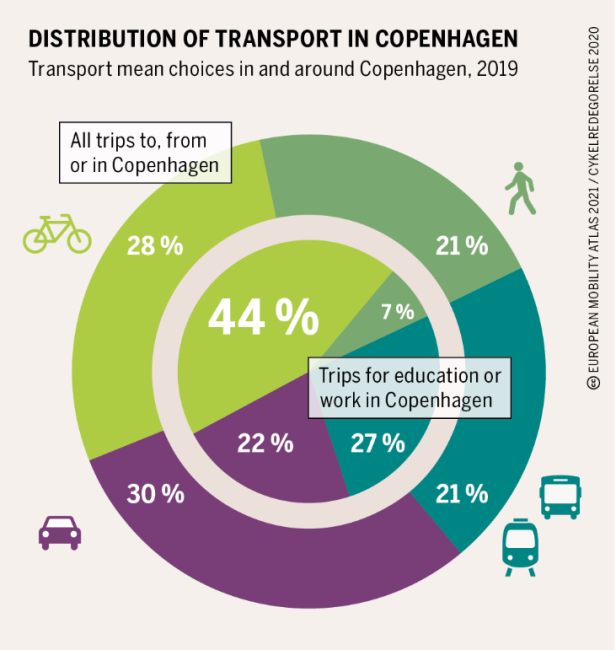Sharon Lezberg, Community Development Educator
“Don’t step off the curb! Watch out!” my daughter Zoey admonished me, as I negligently stepped off the pedestrian curb onto the bike path during a recent visit to Copenhagen. I quickly jumped back up onto the pedestrian walkway, lest I get run down by a bike commuter. Zoey had been studying in Copenhagen during fall semester, and was well versed with pedestrian/bicycle etiquette, and was now educating me about the functionality of the Danish bicycle infrastructure.
Madison is highly regarded as a a good place to ride a bike. Madison is reported to have a greater percentage of bicycle commuters than any other U.S. City (tied with Portland, Oregon). However, the percent of adults who bike to work (6%) is well below that of Copenhagen (44%). And while Dane County has great countryside for biking, the County does not yet have a bike-friendly infrastructure that accommodates all levels of cycling ability.
While retrofitting a city to be bike-friendly may be a costly enterprise, it is an essential design component for climate change mitigation. The Dane County Climate Action Plan has the goal of reducing vehicle miles traveled by 15% by 2050, in order to reduce greenhouse gas emissions from the transportation sector. If we are to design for fewer cars, we’ll need to design for more efficient and safe bicycle, pedestrian, and public transit options.
The bicycle infrastructure in Copenhagen is comprehensively- and safely-designed, and as such, residents can easily make the choice to cycle to work and school. In contrast to cities in the United States, which are built for the automobile, city planners in Copenhagen have prioritized bicycle transit in the capital city since the 1970s, when public demand to prioritize cycling shifted priorities away from cars. By 2019, more trips within the city were made by bicycle than by car (see the graph).
While walking around Copenhagen, I was impressed with the ubiquity of bicycle lanes. The pedestrian walkways were clearly differentiated from the bike lanes making it easy to understand. The unidirectional lanes are wide enough for several cyclists to ride in tandem. While we saw hundreds of regular cyclists (and this during a cold, rainy spell during the winter holidays), we did not see high-speed racing bikes veering between the commuters. On the contrary, the pace was reasonable and comfortable for all, including parents pulling carts with kids.



Integration of cycling with public transportation is another key design feature so that commuters can make the choice to leave the car behind. Cyclists can bring their bikes onto metro trains or buses, and then make the final part of their commute by bike. As Madison and Dane County work to expand the cycling infrastructure, it will be imperative to intentionally plan for integration with public transportation. It’s also important to plan for ample bike parking—something Copenhagen is grappling with now.
In Madison, I try to bike to work and for errands, but I admit that I easily get sucked into the convenience of the automobile. I think that it is easier to make the choice of bike over car when doing so is socially-preferred, safe, and convenient. I can imagine a critical mass of people choosing to bike commute in urban areas of Dane County—but I think there’s several key components that must be in place: a great infrastructure, bike parking, bike rental, numerous bike repair shops. In cities, it helps to have housing density (which makes parking and driving expensive and stressful) and child care options near where people live (so as to avoid disparate routes for working parents). For a culture of biking to emerge, we must also let go of our love of speed, convenience, and individual autonomy—all components of the car culture.
With climate change and rising greenhouse gas emissions, we have no choice but to decelerate the upward trend in vehicle miles traveled. With European cities showing the way, we can design our cities to be bicycle/pedestrian/public transit-friendly, and reduce our reliance on the automobile.


Photo credits: Sharon Lezberg
Want to learn more about climate change? Check out the rest of our posts and subscribe to our Climate Change Blog
Sources:
Dane County Office of Energy & Climate Change. April, 2020. Today’s Opportunity for a Better Tomorrow: 2020 Dane County Climate Action Plan.
Murphy, Chris. Sept 26, 2011 (Bike commuting percentages updated Jan. 11, 2022). “What’s News: Madison tied for the highest percentage of bike commuters in the U.S.” The Cap Times. Accessed 3-2-2023.
Weinreich, Marianne. 3 Feb 2021. Cycling Copenhagen: The Making of a Bike-Friendly City. Heinrich Boll Stiftung European Union. Accessed 3-2-2023.




